Bulletin – September 2012 Exploration and the Listed Resource Sector
- Download the article 377KB
Abstract
A great deal has been written about the importance of the resource sector in Australia; however, most of this focuses on the few large companies that dominate the landscape. The numerous small companies in the sector are discussed less often. These small companies have become an important part of the exploration stage of the commodity production process, particularly in areas that have not previously yielded discoveries. Junior explorers tend to rely almost exclusively on listed equity to finance their operations and the boom in commodity prices over the past decade has meant that these companies have had little trouble raising equity. The resource boom has also resulted in a sharp rise in listings of new resource companies – to the point where nearly half of all listed companies on the ASX are now in the resource sector.
Introduction
The resource boom has had a major impact on the Australian economy over the past decade, increasing real domestic incomes and fostering an investment boom. One outcome of the boom is that resource companies now account for around a third of the market capitalisation of companies listed on the Australian Securities Exchange (ASX), up from around 15 per cent a decade ago. The number of listed resource companies has also risen significantly, with resource companies now accounting for just under half of all listed companies, compared with one-third in 1995. This article examines these small companies and the importance of listed equity in their capital structure.
The Nature of the Listed Resource Sector in Australia
The resource sector has become an increasingly large component of the listed equity market in Australia over the past decade, with the number of resource companies more than doubling over this period (Graph 1). This increase has been broad based across the resource sector, although the increase has been more pronounced for companies involved in mineral exploration and production than for those in the energy industry.[1] The resource sector comprises a few large and generally highly profitable companies, along with a large number of small companies that generate little or no revenue from their operations in any given year (Graph 2). These small companies with market capitalisations of less than $200 million are often referred to as ‘juniors’.

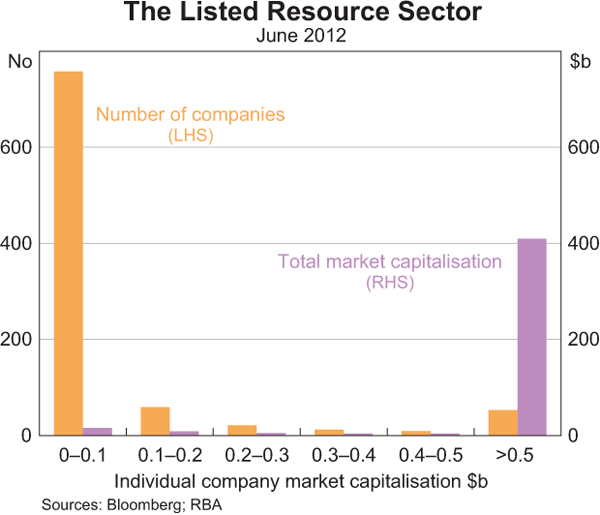
Australia has a much larger proportion of its listed sector concentrated in resource stocks (by both number and market capitalisation) than most other countries, including major commodity exporters (Graph 3). While resource companies from some other regions have larger absolute market capitalisations, these are generally concentrated among a few very large stocks.[2] These regions also tend to have a more diversified listed market generally, while the Australian market is heavily weighted towards resource and financial stocks. The exception to this is Canada, which also has a high share of resource stocks and a large number of very small companies.
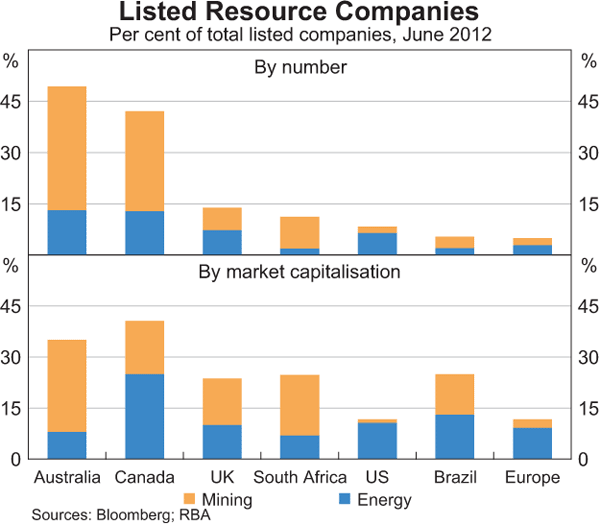
The Role of Junior Explorers
Of the 800 or so small listed resource companies in Australia, the overwhelming majority are engaged in exploration activities (Table 1). Exploration is the first step in the resource production process. Exploration expenditure totalled $7 billion in 2011, accounting for around 10 per cent of total mining investment. It is an investment in knowledge about the key characteristics of a resource deposit and must be undertaken before production can proceed. Once a discovery is made there is an evaluation of the deposit to determine the feasibility of extracting and selling the resource. A project that is deemed viable will then move into a construction phase and finally the operating phase. A ‘junior explorer’ will generally have no projects that have progressed to the operating phase, because they tend to sell their discoveries to larger operators who develop the resource deposits.
| Number | Share of all listed resource companies |
Share of total resource company market capitalisation |
|
|---|---|---|---|
| Oil and gas(b) | 110 | 87 | 8 |
| Coal and consumable fuels | 63 | 75 | 22 |
| Aluminium, steel and diversified miners |
275 | 78 | 5 |
| Gold and other precious metals | 189 | 75 | 19 |
| Total | 637 | 78 | 7 |
|
(a) Companies with no revenue producing operations, except for oil and
gas companies Sources: Bloomberg; Intierra; RBA |
|||
Exploration is required for the continued discovery of resources and is particularly important for commodities that have low proven reserves relative to production (such as oil).[3] However, it is also important for commodities in which there are large proven reserves, for example bulk commodities such as coal and iron ore, as it can allow for higher-quality and/or lower-cost deposits to be identified. Expenditure on bulk commodity exploration increased significantly over the past decade as demand for these commodities rose strongly and now accounts for around 30 per cent of total exploration expenditure in Australia (Graph 4).
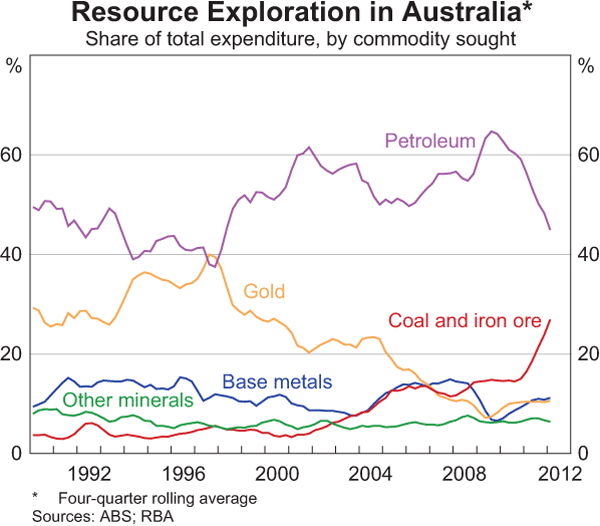
Junior explorers generate a sizeable proportion of total resource discoveries and are particularly important at the earliest stages of the exploration process. Geoscience Australia estimates that they accounted for around 60 per cent of total discoveries of gold and base metals between 1960 and 2002 (Maritz 2003). They are also responsible for an increasing share of exploration expenditure, with estimates suggesting that junior explorers currently account for up to half of total exploration expenditure, compared with around a third a decade ago (Schodde 2011).[4]
While small operators have always been a part of the exploration phase of developing resource endowments in Australia, the increase in their importance is due in part to the withdrawal of larger companies from exploration activities in recent years (Economic Development and Infrastructure Committee 2012). In Australia and globally, many large companies downsized their internal exploration units in the 1990s in response to historically low commodity prices. Large companies have also chosen to focus most of their remaining exploration efforts on brownfield sites (those where there has already been an existing discovery), as this is generally less risky, cheaper and simpler than searching for resources in new locations (known as greenfield exploration). Advances in technology have also meant that these companies can extract more resources from known deposits than was possible previously. In addition, technological improvements have lowered costs, making it possible for junior explorers to fill the gap left by the withdrawal of these larger companies. More recently, high commodity prices have provided a strong incentive for larger companies to quickly expand production from current deposits, rather than undertake greenfield exploration.
Discoveries by junior miners are usually sold to larger operators with the scale and expertise to exploit a deposit (Graph 5). Mergers and acquisition activity indicates that small companies tend to sell their mining leases to mid-cap producers, rather than the large resource companies, as their discoveries are usually not of sufficient scale to interest them initially.[5] After the sale, the explorer will typically revert to exploring for other deposits.
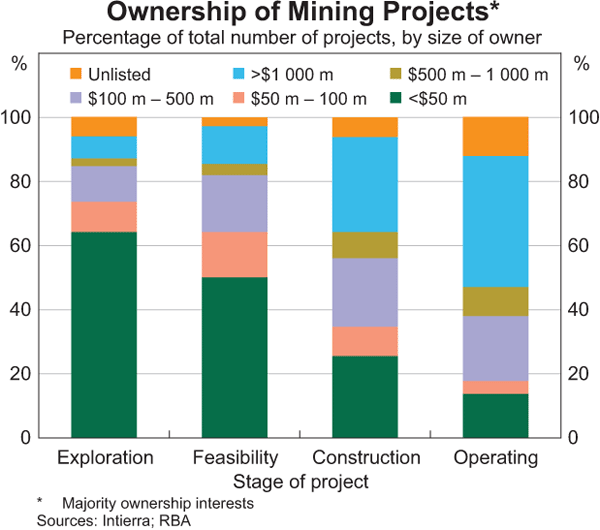
Resource exploration is relatively cyclical, increasing during periods when commodity prices are high and declining when they are low (Graph 6). This occurs because higher prices make any potential discovery worth more and tend to make exploration in marginal areas more attractive. Not surprisingly, junior explorers also find it easier to obtain funding during periods of high prices. Expenditure on exploration as a share of GDP reached a multi-decade low in the early 2000s as commodity prices fell to unusually low levels, but has since increased to its highest level since the mid 1980s. The recent increase has been driven primarily by the increase in exploration for iron ore and coal.
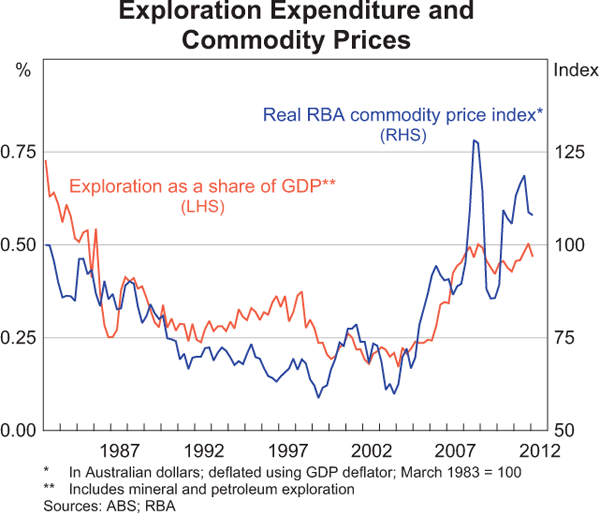
Funding of Junior Explorers
The resource sector is the only industry sector in Australia where listed companies make up a substantial portion of the total number of businesses (Table 2).[6] This is largely explained by the fact that listed equity is the only viable source of funding for businesses conducting high-risk exploration activities. The diversified investor base provided by an exchange listing also helps support the capital-intensive nature of resource exploration.
| Share of total businesses |
Share of total companies |
|
|---|---|---|
| Resources | 10.8 | 47.4 |
| Rental, hiring & real estate services | 0.1 | 15.4 |
| Agriculture | 0.0 | 4.8 |
| Manufacturing | 0.3 | 4.3 |
| Other services | 0.0 | 3.6 |
| Construction, transport & other | 0.0 | 1.3 |
| Wholesale & retail trade | 0.0 | 0.8 |
| All sectors | 0.1 | 5.5 |
|
Sources: ABS; Dun & Bradstreet (Australia); Morningstar; RBA |
||
Ordinarily, firms will first seek to use internal funding (i.e. retained profits) to finance their activities as this usually has the lowest opportunity cost. If external funding is required then firms will prefer to use debt financing in the first instance, with external equity usually a last resort.[7] Large resource firms typically follow this model of funding because they have operations that generate positive cash flows, which usually allow significant retained earnings and a capacity to service debt repayments. In fact, these cash flows have been so large in recent years that a few of these companies have conducted share buybacks.
In contrast, junior explorers rely largely on listed equity to fund themselves because they generally produce little in the way of consistent revenue and so are unable to rely on internal sources of capital. A lack of stable earnings and the risky nature of exploration also make it difficult for them to obtain debt funding. Given their inherently speculative nature, around 80 per cent of junior resource companies record a net loss in any given year, although if these companies make a discovery, the payoff is usually very large (Graph 7). It is this high-risk/high-return profile that makes these companies attractive to some investors. These investors will typically spread out their investment over a number of companies, with the expectation that a few of them will make discoveries and provide a large payoff.

By listing on equity markets, junior explorers are also able to periodically re-tap their equity investor base (Graph 8). These secondary raisings are usually conducted to fund further exploration activity when the explorer fails to make a discovery (Graph 9). This ability to periodically raise equity, along with the fact that most of these companies have little or no debt, means that very few of these companies get wound-up despite their tendency to make losses (Schodde 2009).[8] The proceeds from secondary equity raisings may also be used to develop a discovery themselves, or in partnership with another company, although this is less common.
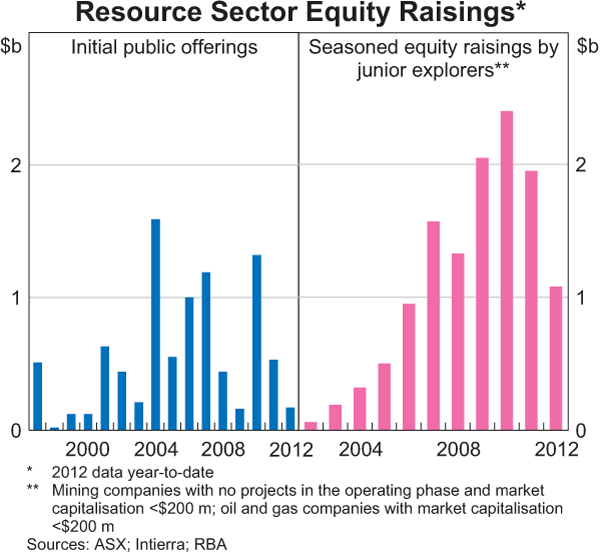
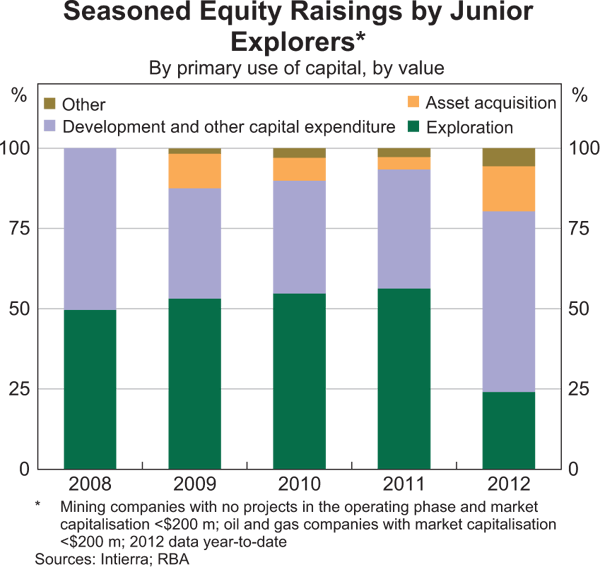
Junior explorers receive little funding from private equity. The start-up nature of junior explorers and their high-risk/return profile would suggest that they are relatively well suited to the venture capital model of investment. However, private equity funding in both Australia and overseas is concentrated in industries such as information technology and clean energy. One reason for this is that exploration companies provide limited scope for private equity managers to add value and control risk through participation in management of the company (Maritz 2003). Another possible explanation is that exploration companies typically return to the market for capital every couple of years, regardless of the initial success of the company, which may be a deterrent to private equity investors.
An analysis of the share registries of junior explorers suggests that large resource companies have only minimal holdings, which indicates that large resource companies rarely ‘sponsor’ these small companies.[9] Instead, equity raising data indicate that institutional investors hold most of the equity in these companies.
Conclusion
Junior exploration companies are an important part of the resource sector, particularly at the earliest stages of the exploration process. This makes them essential to the ongoing viability of the resource sector in Australia as greenfield discoveries add to the stock of proven reserves. Throughout the resource boom these companies have had little trouble raising equity; however, their access to capital is likely to be constrained when commodity prices fall.
Footnotes
The author is from Domestic Markets Department. [*]
This breakdown is based on the Global Industry Classification Standard (GICS). Energy companies include those involved in oil, gas and coal industries. [1]
For example, as of 30 June 2012 the two largest US resource companies, Exxon Mobil and Chevron, had a combined market capitalisation of A$580 billion. This compares to the combined market capitalisation of A$440 billion for the entire listed resource sector in Australia. [2]
In 2011, exploration expenditure as a share of the total value of exports was around 10 per cent for oil and gas but only 1–2 per cent for iron ore and coal. [3]
Metals Economics Group estimates that junior explorers account for around 40 per cent of global exploration, up from 25 per cent in 2000 (Chender 2011). [4]
Where a mid-cap producer is defined as a company with market capitalisation between $200 million and $1 billion. [5]
Businesses include companies and other unincorporated structures such as sole traders, partnerships, etc. [6]
External equity financing is typically the most expensive source of capital. [7]
Even if the company is unable to raise more equity, it is rare for them to delist. Most of these companies will simply remain as ‘shell’ companies until they are bought out or are able to raise more equity. [8]
Large resource companies typically have wholly owned unlisted subsidiaries rather than ownership stakes in small listed companies. [9]
References
Chender M (2011), ‘Global Exploration Trends’, presentation to the CESCO Exploration Forum, Santiago, Chile, 4 April.
Economic Development and Infrastructure Committee (2012), Inquiry into Greenfields Mineral Exploration and Project Development in Victoria, Victorian Parl Paper No 136, May.
Maritz A (2003), ‘Tax Incentive Options for Junior Exploration Companies’, ABARE report for the Department of Industry, Tourism and Resources, April.
Schodde R (2009), ‘The Way Forward for the Junior Sector in Difficult Times’, presentation to the AusIMM Technical Meeting, Melbourne, 7 July.
Schodde R (2011), ‘Recent Trends in Australian Exploration’, presentation to the AMEC Convention 2011, Perth, 28 June.